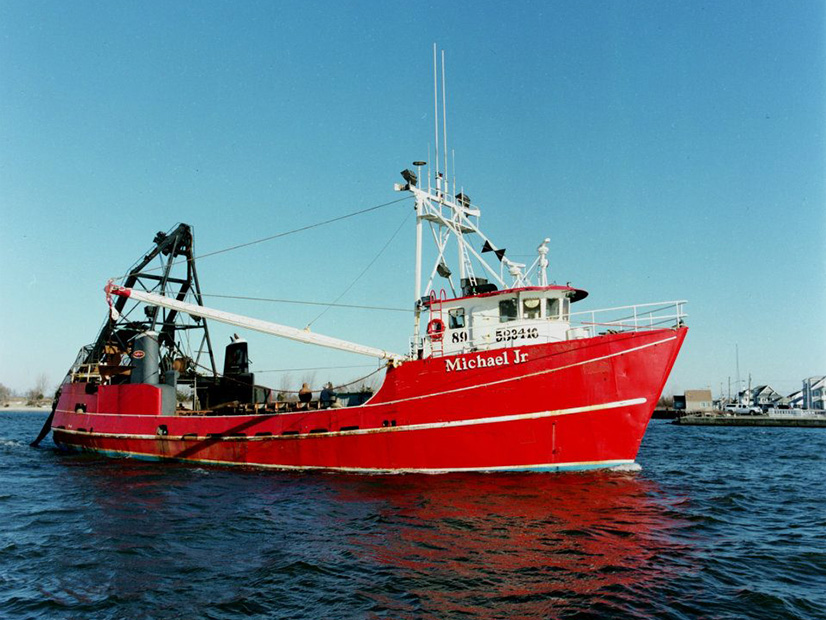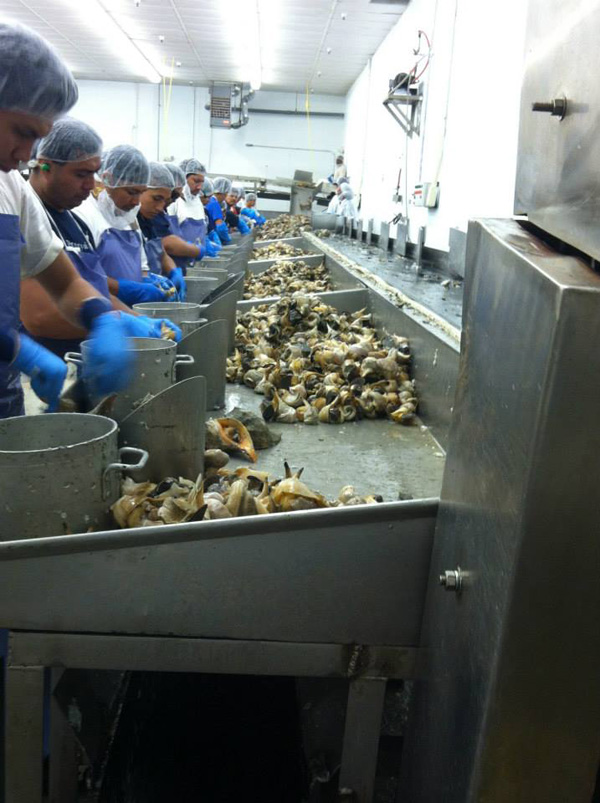
New Jersey fishermen vigorously opposed the Atlantic Shores offshore wind farm at a recent set of federal Bureau of Ocean Energy Management (BOEM) hearings, with one fish supplier saying the project would render a key clam harvesting area unfishable.
Daniel LaVecchia, president of Lamonica Fine Foods, which produces clam and other seafood products, told the second BOEM hearing on Oct. 21 that the proposal to build up to 200 wind turbines one mile apart would prevent clam fishermen from working the area. Because the project is sited in two of the most important clam harvesting areas in the East Coast, its development presents a major “threat to our continued existence,” LaVecchia told the hearing.
“Our income from those two key clamming areas is well documented,” LaVecchia said. “Our financial losses will be highly significant if we cannot continue our clamming fishery in those areas.”
 Workers process seafood at LaMonica Fine Foods. | LaMonica Fine Foods
Workers process seafood at LaMonica Fine Foods. | LaMonica Fine FoodsLaVecchia was one of several fishing industry representatives at the hearings who expressed concerns about the Atlantic Shores project, while most speakers — among them environmentalists, elected officials and union representatives — voiced strong support. Many cited the urgent need to cut carbon emissions to address the increasingly extreme storms and floods that have pummeled the state in recent years.
The project, a joint venture between EDF Renewables North America (PA:EDF) and Shell New Energies US (AMS:RDSA), would create 1,510 MW of electricity that would power 700,000 homes. Two other offshore wind projects approved by the BPU for the New Jersey coast — the 1,100-MW Ocean Wind 1 project and the 1,148 MW Ocean Wind 2 — are in development by Denmark-based Ørsted.
Warming Fish Habitats
Not all fishermen oppose the Atlantic Shores project. Two charter boat captains that take day tripping fishermen out into the ocean welcomed the project’s advance, saying the need to combat climate change is imperative, and the wind farm could actually improve the available fishing area.
“I myself am looking forward to this project,” Captain Brian Williams, who runs Badfish Fishing Charters of Ocean City, N.J., told the first BOEM hearing. “It’ll create a lot of good fish habitat and hopefully some good fishing.”
Captain Paul Eidman, operator of Reel Therapy Fly and Light Tackle Fishing Charters, said fishermen are already seeing fish move north because of the warming of the ocean.
“There isn’t a fisherman out there, either commercial or recreational, that doesn’t see the effects of climate change on the water every single day,” he said. “These offshore wind turbine structures are likely to become fishing hotspots due to the artificial reef effect.”
But a representative of industrial scale fish companies that rely on pulling a large volume of fish from the sea echoed LaVecchia’s concern. David Wallace, who spoke at all three hearings and represents several food processors along the East Coast who also own fishing boats, said the design of Atlantic Shores leaves too little space for the vessels to navigate.
The combination of the weight of the fishing nets — clam dredges, for example, can be five to seven tons when empty — and the combination of the waves, wind and tides passing through rows of turbines can create unpredictable currents that will make it exceedingly difficult to fish among the turbines, he said.
“It is like trying to tow an anchor, and so it severely limits your ability to navigate,” he said. “It is easy to imagine that a ship could lose control in a tight place and be swept into these turbines.”
Wallace said he has urged developers and government agencies to space turbines two miles apart, to no avail.
Climate Change Urgency
Offshore wind farms would generate 23% of the state’s energy under Gov. Phil Murphy’s effort to reach 100% clean energy by 2050. Along with the three offshore wind projects approved to date, the state plans to hold three more solicitations over the next five years and approve a total of 7,500 MW by 2035.
Asked about the claim that turbines one mile apart could be dangerous for fishermen, Atlantic Shores responded that it wants to “co-exist successfully” with the fishing sector, adding that “working closely with our neighbors in the community is central to our mission.
“Nothing threatens the fishing industry more than the impacts of climate change,” the company said in a statement to NetZero Insider when asked about the concerns of fishermen. “And offshore wind is an important way to mitigate those impacts while preserving our oceans.”
“Atlantic Shores will not block any fishing in its lease area,” the company said, adding that it will continue the “two-way dialogue with the fishing community, particularly the surf clam and recreational fishing communities.”
The company also noted that it is working with Rutgers University and Stockton University to “better understand ocean conditions, species composition, and habit distribution to minimize any impact.”
In February, a report by five Rutgers researchers who reviewed three decades of research on northern European offshore wind installations concluded that offshore wind farms could have an impact on the annual cycle of ocean water temperatures that are critical to the region’s fish and shellfish habitat,
The researchers studied research on the impact of the farms on tidal currents, temperatures and sediments. In particular, they looked at the impact on the “cold pool,” the layer of colder water close to the sea floor that is important to the survival of species such as scallops and surf clams, in part because it drives the production of nutrients.
An update of the paper, released in July, came to no firm conclusion, saying there remains a “great deal of uncertainty” over the issue. “Changes in stratification could have important consequences in cold pool setup and degradation, processes fundamental to high fishery productivity of the region,” the report said. Travis Miles, one of the researchers, said that because New Jersey’s oceanography is different than Europe’s, the impact of the turbines may not be known for certain until they are operating and can be studied.
Differing Environmental Concerns
Doug O’Malley, Director of Environment New Jersey, told the first BOEM hearing on Oct. 19 that New Jersey is uniquely vulnerable to the ravages of nature because of climate change. The offshore wind projects are key to the state’s effort to reducing carbon emissions and mitigating the worst effects of global warming.
“The Jersey Shore is sinking more than others at other coastal communities. We’ve seen the sea level rise at the shore that is massively higher” than elsewhere, he said. He cited a 2018 study by the Union of Concerned Scientists that found that 250,000 New Jersey homes worth more than $100 billion dollars were at risk from tidal flooding, the second highest number of homes in jeopardy of any state in the nation.
Yet even some environmentalists worry about the impact of the turbines on the fish and their habitat. Kari Martin, advocacy campaign manager for Clean Ocean Action, a coalition of conservation, environmental, fishing and water recreation interests, urged BOEM to extend the comment period for Atlantic Shores because of its scale and potential impact.
“We are concerned about the noise and the navigational risks, and the potential impacts and collisions, accidents and spills that can result and harm our marine ecosystem,” he said.
Nancy Solomon, director of Long Island Traditions, a New York-based nonprofit that advocates for the preservation of traditional culture, called for a study on “impacts to offshore fishermen, local bayman and shellfish beds in New Jersey.” She said the windfarm developers should “establish a mitigation fund for the impacted fishermen bayman and people in these coastal communities who have shared family traditions that date back well over 100 years.”
But Agnes Marsala, a member of Empower New Jersey, said turbines offer the opportunity to bring “good jobs and an abundance of energy to the northeast.”
“I realize the fishing industry might be impacted,” she said. “But the single biggest revenue loss to fishermen is climate change. All the fishery management plans in the world mean nothing, if global warming forces species out of Atlantic waters.”

